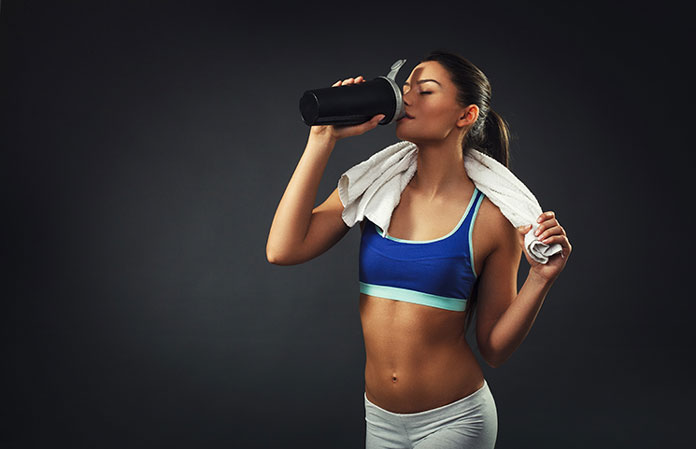Regular physical activity, cardio, and resistance training all place a large amount of stress on the body that is ultimately good for overall health. Performing physically intensive activities causes the body to expend energy, but also depletes the water levels of the body through sweat in an attempt to thermoregulate.
Remaining hydrated before, during, and after physical activity is essential in order to remain healthy and get the most out of any training regimen, but it depletes a key element of the body- electrolytes. The athletic performance capacity of the body is closely linked to electrolyte balance, which can be disrupted extremely quickly during periods of intense activity.
The body uses electrolytes in the function of the central nervous system, the organs, and the muscles. When electrolyte levels fall by just 2%, many different biological responses can ensue, including muscle cramps, decreased strength and power, and total body fatigue.
In order to hit PR’s, build new muscle mass, and burn fat, it’s extremely important to focus not only on rehydration, but also on electrolyte balance. In this article, we’ll take a look at electrolytes, find out what they are and what they do, and present some nutritional strategies that can help you maximize your performance and avoid electrolyte depletion.
What Are Electrolytes?
Electrolytes play a critical role in the function of most bodily systems, but are extremely simple molecules. Consisting of salt ions dissolved in fluid, electrolytes come in many different shapes and sizes, but all share the ability to conduct electricity.
There are many different electrolytes that are integral to total body health, but in this article we’ll focus on the four most important electrolytes for physical performance and training: sodium, potassium magnesium, and calcium.
Sodium
Sodium, or salt is the most common electrolyte, and is used by the body for a vast range of different functions. The body uses salt to regulate blood pressure, create new red blood cells, transmit neural impulses, balance the fluid content of the body, and contract muscle tissue.
The sodium levels of the body are extremely important to healthy neurological function, and are used to activate neurons and for muscle activity. When sodium levels become low, the ability of muscle tissue to contract becomes weaker, and can cause them to “misfire”, resulting in muscle cramps.
The minimum daily sodium intake for a healthy adult is around 500 mg daily. The upper limit of recommended daily sodium intake is around 2,300 mg, but most individuals consume more than this due to the high sodium content of the modern diet. Individuals following specific dietary regimen may also need to consume higher levels of sodium, such as keto dieters, who need to consume around 5,000 mg daily.
For athletes and fitness enthusiasts participating in intensive physical activity, however, sodium intake requirements increase dramatically. Clinical investigations into the sodium intake requirements of individuals performing physical training have shown that 8,500 mg of sodium lasts just two hours of training, making sodium replenishment essential to maximizing performance output.
Whether you’re performing regular cardio training, resistance-based strength training, or playing a sport, providing your body with adequate sodium is a powerful way to elevate your strength, agility, speed, and overall fitness.
Potassium
Sodium is extremely important to the inner workings of the cells, but a different electrolyte is used by the body outside of the intracellular environment. Potassium is another critical electrolyte that is used by the body to regulate cardiovascular function, muscle function, and circulatory health.
During periods of peak performance, the body uses potassium to maintain electrolyte balance and promote higher levels of bioelectrical conductivity between cells. The nerves of the body transmit electrical neural impulses as part of the neurotransmission process, and as such the increased electrical conductivity provided by potassium assists with the communication process between them.
In a similar manner to sodium, the body loses a massive amount of potassium through sweat and oxidation during periods of peak physical activity. Providing the body with a steady stream of potassium before, during, and after training sessions is as important as sodium replenishment, as it’s similarly critical to the muscle contraction process and the transmission of neural impulses.
The symptoms of potassium deficiency are more or less the same as sodium deficiency- when potassium levels become low due to intensive exercise, muscle cramping occurs that can result in minimized power output, fatigue, and even injury. The body also uses potassium to convert carbohydrates into stored glucosamine energy, so if you’re not getting enough potassium, chances are you’re not operating at your peak ability levels.

Magnesium
Magnesium is often the most overlooked electrolyte, but plays an equally important role in promoting high levels of physical output. Magnesium is critical to more than 300 different biological processes in the body, and is used by the body to prevent inflammation, regenerate damaged tissue, and even in the synthesis of DNA and RNA.
To put the importance of magnesium into perspective, it’s the fourth most common mineral in the human body, and is essential to the function of the muscles and the nerves. The body uses magnesium to maintain cardiovascular balance, regulate the immune system, and transport adenosine triphosphate- the energy currency of the body- throughout the bloodstream.
Magnesium is also used in the formation of healthy bones and teeth, and even modulates blood sugar levels. Magnesium, however, can be one of the most difficult electrolytes to supplement, as it’s commonly provided in magnesium oxide form, which is not easy for the body to break down and absorb quickly.
It’s best to take magnesium in a more bioavailable organically bonded form, such as magnesium chelate, or source it from leafy green vegetables and nuts. Fortunately, magnesium is not depleted as fast as other electrolytes, making it possible to supplement it through nutritional strategy.
Calcium
Calcium is without a doubt the most common mineral in the human body. Most of us associate calcium with healthy teeth and bone growth, but it’s also used for a wide range of other functions in the body. Like the other electrolytes outlined above, calcium is essential for nerve impulse transmission, blood pressure, blood clotting, and muscle contraction.
It’s important to keep calcium levels high, as when calcium levels are depleted due to high intensity physical activity, the body will draw calcium from the bones to compensate. If this process occurs often enough, the structure of the musculoskeletal system will become compromised, resulting in the development of osteoporosis.
Why Electrolytes Are Important
Electrolytes are used by the body to control a wide range of functions, including thermoregulation, or temperature control, respiratory function, renal function, digestion, immune system response, neurological function, energy production, and glucose metabolism.
A surprising fact about electrolytes is that consuming a sports drink, such as Powerade, does not provide the body with electrolytes that it can use in that precise moment. It’s necessary to provide the body with a steady stream of either dietary electrolytes or electrolyte supplements in order to ensure your body is prepared to deal with increased electrolyte demand during intensive physical activity.
Electrolyte Imbalance: Causes & Symptoms
Apart from intensive physical activity, there are many other factors that can contribute toward electrolyte deficiency or electrolyte imbalance. Temporary illnesses are a major cause of electrolyte imbalance, as they often cause excessive water loss that carries electrolytes out of the body.
The most common cause of electrolyte imbalance is fluid loss, but there are a number of other common situations in which the body demands a higher electrolyte intake level. Any illness that induces diarrhea, vomiting, excessive sweating, or urination can deplete electrolytes, as can hormonal imbalances or digestive issues that interfere with the ability of the body to absorb nutrients from food.
Another common cause of electrolyte deficiency is poor nutritional intake, or following a diet that doesn’t provide the body with the minerals it needs to thrive. Kidney disease, kidney damage, chemotherapy, corticosteroids, diuretics, and antibiotics are all less common sources of electrolyte imbalance that can interfere with the overall health of the body.
When the body becomes deficient in electrolytes, a number of symptoms begin to manifest. The most common symptom of electrolyte imbalance or depletion is muscle cramping, but the condition may also manifest as muscle weakness, twitching, or spasms.
Electrolyte imbalance can also induce a range of neurological and psychological symptoms, such as anxiety, headaches, restlessness, insomnia, and high stress levels. Some of the other physiological symptoms of electrolyte imbalance include digestive pain, joint pain, low blood pressure, dizziness, and even irregular heart beat.
The most severe symptoms of electrolyte imbalance results in severe neuroinflammation, confusion, and even loss of consciousness. If you’re experiencing any of these symptoms, it’s important to consult a medical professional as soon as possible. The less severe symptoms of electrolyte imbalance, however, can quickly and easily be reversed through the use of electrolyte supplements.
Electrolyte Replenishment Strategies
There are a number of different strategies that can be used to prevent electrolyte imbalance or deficiency from occurring. The most important element of any electrolyte replenishment strategy is diet. The modern diet is saturated with over processed foods that possess little to no nutritional value, which makes electrolyte deficiency extremely common.
Simply drinking water on a regular basis isn’t enough to keep your total electrolyte levels balanced. While it’s important to consume an average of eight glasses of water daily, it’s also possible to overhydrate, inducing nausea, bloating, and even seizures. As electrolyte imbalance generally manifests as the sensation of thirst, it can often cause individuals to overhydrate.
Focusing on boosting your electrolyte intake through the consumption of healthy and natural whole foods is a powerful way to balance total body health, but if you’re performing intensive physical activity on a regular basis, you may want to consider some of the following strategies to ensure your body is being provided with everything it needs:
Nutritional Intake Management
The first and most important step to take when seeking to promote electrolyte balance in your body is to assess your diet. A balanced diet should be rich in foods that contain large amounts of micronutrients and minerals. Whole foods typically provide the body with a far more bioavailable source of electrolytes, and deliver secondary benefits such as the elimination of oxidative stress and inflammation.
Some of the best foods to incorporate into your diet to elevate organic electrolyte intake are leafy greens such as kale, spinach, and spirulina. Nuts are another great source of electrolytes, as are carrots, citrus fruits, bell peppers, yogurt, celery, and watermelon.

Medication Assessment
There are a number of different medications that can interfere with the electrolyte balance of the body. Antibiotics are known to interfere with electrolyte retention, as are blood pressure medications, hormonal pills and topical corticosteroids for skin conditions.
Taking laxatives or diuretics to assist with digestive disorders also causes high levels of fluid loss, which carries electrolytes out of the body. Using these pharmaceutical solutions on a regular basis can induce dangerous levels of electrolyte deficiency, and even worsen the symptoms of the illnesses they are designed to treat.
Electrolyte Refueling
Ensuring you’re providing your body with electrolytes is generally achieved by supplementing with a steady stream of electrolytes before, during, and after the workout period.
We’ll proceed to break down the optimal strategies for electrolyte refuelling in each stage of the training process.
Pre-Workout Electrolyte Supplementation:
Pre-Workout Electrolyte Supplementation should be performed 30 minutes prior to exercise, and is arguably the most important element of electrolyte supplementation. Pre-workout electrolyte supplementation is best achieved by drinking roughly 20 fluid ounces of water alongside electrolytes in whole food form, such as crackers, pretzels, or other salty foods.
Intra-Workout Electrolyte Supplementation:
Intra-Workout Electrolyte Supplementation should consist of regular, small servings of fluid between 6 and 8 oz. An electrolyte sports drink is a great way to boost electrolyte intake during a workout, but it’s important to look for a sports drink or drink mix that doesn’t contain excessive amounts of sugar.
Post-Workout Electrolyte Supplementation:
Post-Workout Electrolyte Supplementation requires a little more preparation.By weighing your body both before and after working out, it’s possible to calculate your net fluid loss. For every pound of weight lost after a workout, it’s best to consume roughly 20 oz of fluid with an electrolyte supplement.
Maintenance Electrolyte Supplementation:
Maintenance Electrolyte Supplementation, like pre-workout electrolyte supplementation, is best performed with whole foods. Integrating electrolyte-rich foods such as leafy green vegetables, nuts, tuna, and legumes is a powerful electrolyte maintenance strategy that will protect the body from electrolyte deficiency in the long term.
Electrolyte Supplement Guide
In this guide, we’ve mentioned electrolyte supplementation several times, but choosing the right electrolyte supplement source can be a difficult process. There are several different options available to fitness enthusiasts seeking to balance their electrolyte intake- we’ll proceed to break down the most popular and effective options:
1. Coconut Water
Coconut water is a rich source of many different micronutrients and minerals. Health and fitness enthusiasts fitness around the world incorporate coconut water into their nutritional strategies for the broad spectrum of phytonutrients it contains.
One ounce of coconut water contains a massive 61 mg serving of potassium and a 5.45 mg dose of sodium, which provide the body with the two most important electrolytes. Coconut water is also extremely low in sugar when compared to most sports drinks, making it a far healthier low-calorie choice.
2. Sports Drink Mixes
Sports drinks and sports drink mixes, if chosen correctly, are the most effective way to replenish electrolytes without an excessive caloric imbalance. As a general rule, it’s best to avoid sports drinks such as Powerade and Gatorade, as these products contain massive amounts of sugar that disrupt blood glucose levels.
One of the best electrolyte supplements available on the market today is Naturalyte by MTS Nutrition. Offering a comprehensive electrolyte blend with minimal carbohydrate content, the Naturalyte formula is enhanced with the addition of betaine nitrate and active caffeine to help fitness enthusiasts get the most out of every workout.
What Are Electrolytes & 7 Healthy Tips To Replenish Cellular Energy Final Thoughts
Building a powerful physique and improving total physical conditioning involves much more than simply lifting weights. A dynamic electrolyte replenishment strategy is the cornerstone of any comprehensive training plan, and should be taken seriously in order to achieve optimal results.









